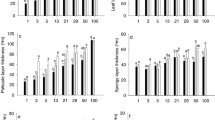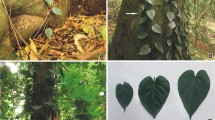Abstract
We used Y-plant, a computer-based model of crown architecture, to examine the implications of leaf reorientation resulting from petiole bending in Psychotria limonensis (Rubiaceae) seedlings. During this reorientation process, bending of the petioles of lower leaves that are potentially self-shaded by the upper leaves rotates the lamina around the stem's orthotropic axis so that self-shading is reduced. Simulations of daily light capture and assimilation revealed a 66% increase in daily C gain due to reorientation of the leaves as compared to simulations where the leaves remained in their characteristic opposite decussate pattern set by the phyllotaxy. This was due to enhanced carbon (C) gain of the lower leaves because of the reduction of shading by upper developing leaves in the same vertical plane. The light signal for this movement was experimentally examined by placing leaf-shaped filters above already fully expanded leaves and following the resulting shade-avoiding movements. The filters were either neutral density shade cloth that reduced the photon flux density (PFD) but did not alter the red to far red ratio (R:FR) or a film that reduced the PFD equivalently but also reduced the R:FR. Leaf reorientation was much more rapid and complete under the low R:FR as compared to the high R:FR indicating involvement of a phytochrome photosensory system that detected the presence of a shading leaf. Plants in gaps were found to lack a reorientation response indicating that the reorientation is specific to the shaded understory environment.






Similar content being viewed by others
References
Ackerly DD, Bazzaz FA (1995) Seedling crown orientation and interception of diffuse radiation in tropical forest gaps. Ecology 76:1134–1146
Ballare CL (1994) Light gaps: sensing the light opportunities in highly dynamic canopy environments. In: Caldwell MM, Pearcy RW (eds) Exploitation of environmental heterogeneity by plants: ecophysiological processes above-and belowground. Academic Press, San Diego, Calif., pp 73–110
Ballare CL (1999) Keeping up with the neighbours: phytochrome sensing and other signaling mechanisms. Trends Plant Sci 4:97–102
Ballare CL, Casal JJ, Kendrick RE (1991) Responses of light-grown wild-type and long-hypocotyl mutant cucumber seedlings to natural and simulated shade light. Photochem Photobiol 54:819–826
Bell AD (1991) Plant form: an illustrated guide to flowering plant morphology. Oxford University Press, Oxford
Casal JJ (2000) Phytochromes, cryptochromes, phototropin: photoreceptor interactions in plants. Photochem Photobiol 71:1–11
Chazdon RL (1985) Leaf display, canopy structure and light interception of two understory palm species. Am J Bot 72:1493–1502
Chazdon RL, Pearcy RW, Lee DW, Fetcher N (1996) Photosynthetic responses of tropical forest plants to contrasting light environments. In: Mulkey SS, Chazdon RL, Smith AP (eds) Tropical forest plant ecophysiology. Chapman and Hall, New York, pp 5–55
Croat TB (1978) Flora of Barro Colorado Island. Stanford University Press, Stanford
Ehleringer J, Forseth I (1980) Solar tracking by plants. Science 210:1094–1098
Fisher JB (1986) Branching patterns and angles in trees. In: Givnish TJ (ed) On the economy of plant form and function. Cambridge University Press, Cambridge, pp 493–523
Forseth IN, Ehleringer JR (1983) Ecophysiology of two solar tracking desert winter annuals. IV. Effect of leaf orientation on calculated daily carbon gain and water use efficiency. Oecologia 58:10–18
Givnish TJ (1982) On the adaptive significance of leaf height in forest herbs. Am Nat 120:353–381
Givnish TJ (1995) Plant stems: biomechanical adaptation for energy capture and influence on species distribution. In: Gartner BL (ed) Plant stems: physiology and functional morphology. Academic Press, San Diego, Calif., pp 3–49
Halle F, Oldemann RAA, Tomlinson PB (1978) Tropical trees and forests: an architectural analysis. Springer, Berlin Heidelberg New York
Hatta H, Honda H, Fisher JB (1999) Branching principles governing the architecture of Cornus kousa (Cornaceae). Ann Bot 84:183–193
Honda H, Hatta H, Fisher JB (1997) Branch geometry in Cornus kousa (Cornaceae): computer simulations. Am J Bot 84:745–755
Iino M (1990) Phototropism — mechanisms and ecological implications. Plant Cell Environ 13:633–650
Kao WY, Forseth IN (1992) Dirunal leaf movement, chlorophyll fluorescence and carbon assimilation in soybean grown under different nitrogen and water availabilities. Plant Cell Environ 15:703–710
Koller D (1990) Light-driven leaf movements. Plant Cell Environ 13:615–632
Lee DW (1987) The spectral distribution of radiation in two neotropical rainforests. Biotropica 19:161–166
Liscum E, Stowe-Evans EL (2000) Phototropism: a "simple" physiological response modulated by multiple interacting photosensory-response pathways. Photochem Photobiol 72:273–282
Lotscher M, Nosberger J (1997) Branch and root formation in Trifolium repens is influenced by the light environment of unfolded leaves. Oecologia 111:499–504
Marcuvitz S, Turkington R (2000) Differential effects of light quality, provided by different grass neighbours, on the growth and morphology of Trifolium repens L. (white clover). Oecologia 125:293–300
Morgan DC, Smith H (1979) A systematic relationship between phytochrome-controlled development and species habitat, for plants grown in simulated natural radiation. Planta 145:253–258
Morgan DC, O'Brien T, Smith H (1980) Rapid photomodulation of stem extension in light-grown Sinapsis alba L. Planta 150:95–101
Niinemets U (1998) Adjustment of foliage structure and function to a canopy light gradient in two co-existing deciduous trees. Variability in leaf inclination angles in relation to petiole morphology. Trees 12:446–451
Niklas KJ (1988) The role of phyllotactic pattern as a "developmental constraint" on the interception of light by leaf surfaces. Evolution 42:1–16.
Niklas KJ (1992) Petiole mechanics, light interception by lamina, and economy in design. Oecologia 90:518–526
Pearcy RW (1999) Responses of plants to heterogeneous light environments. In: Pugnare FI, Valladares FV (eds) Handbook of functional plant ecology. Decker, New York, pp 269–314
Pearcy RW, Valladares F (1999) Resource acquisition by plants: the role of crown architecture. In: Press MC, Scholes J, Barker M (eds) Plant physiological ecology. Blackwell Science, Oxford, pp 45–66
Pearcy RW, Yang W (1996) A three-dimensional crown architecture model for assessment of light capture and carbon gain by understory plants. Oecologia 108:1–12
Pearcy RW, Yang W (1998) The functional morphology of light capture and carbon gain in the Redwood forest understorey plant Adenocaulon bicolor Hook. Funct Ecol 12:543–552
Pickett STA, Kempf JS (1980) Branching patterns in forest shrubs and understory trees in relation to habitat. New Phytol 86:219–228
Smith H (1995) Physiological and ecological function within the phytochrome family. Annu Rev Plant Physiol Plant Mol Biol 46:289–315
Takenaka A (1994) Effects of leaf blade narrowness and petiole length on the light capture efficiency of a shoot. Ecol Res 9:109–114
Takenaka A, Takahashi K, Kohyama T (2001) Optimal leaf display and biomass partitioning for efficient light capture in an understorey palm, Licuala arbuscula. Funct Ecol 15:660–668
Thompson L (1995) Sites of photoperception in white clover. Grass Forage Sci 50:259–262
Valladares F (1999) Architecture, ecology and evolution of plant crowns. In: Pugnaire FI, Valladares F (eds) Handbook of functional plant ecology. Decker, New York, pp 121–194
Valladares F, Pearcy RW (1998) The functional ecology of shoot architecture in sun and shade plants of Heteromeles arbutifolia M. Roem., a Californian chaparral shrub. Oecologia 114:1–10
Valladares F, Wright SJ, Lasso E, Kitajima K, Pearcy RW (2000) Plastic phenotypic response to light of 16 congeneric shrubs from a Panamanian rainforest. Ecology 81:1925–1936
Waller DM, Steingraeber DA (1986) Branching and modular growth: theoretical models and empirical patterns. In: Cook R, Buss L, Jackson JBC (eds) Biology of clonal organisms. Yale University Press, New Haven, Conn., pp 35–70
Yamada T, Okuda T, Abdullah M, Awang M, Furukawa A (2000) The leaf development process and its significance for reducing self-shading of a tropical pioneer tree species. Oecologia 125:476–482
Acknowledgements
This research was supported by NSF grant IBN-9604424 and a Smithsonian Tropical Research Institute Short Term Fellowship awarded to D. G. We thank Dr S. J. Wright and the Smithsonian Tropical Research Institute for providing facilities and support that made this research possible. Thanks to Drs Egbert Leigh, Fernando Valladares, Timothy R. H. Pearson, Thomas Kursar and Jim Dalling for their valuable comments and suggestions for the manuscript. D. G. thanks Prof. Claudia Peralta of University of Panama for critical discussion during early stages of the project and for comments on the manuscript.
Author information
Authors and Affiliations
Corresponding author
Rights and permissions
About this article
Cite this article
Gálvez, D., Pearcy, R.W. Petiole twisting in the crowns of Psychotria limonensis: implications for light interception and daily carbon gain. Oecologia 135, 22–29 (2003). https://doi.org/10.1007/s00442-002-1158-3
Received:
Accepted:
Published:
Issue Date:
DOI: https://doi.org/10.1007/s00442-002-1158-3




